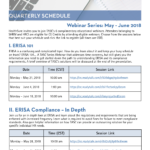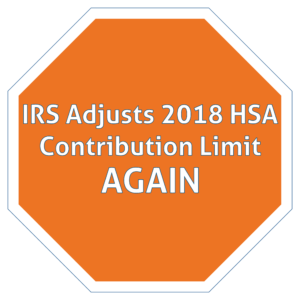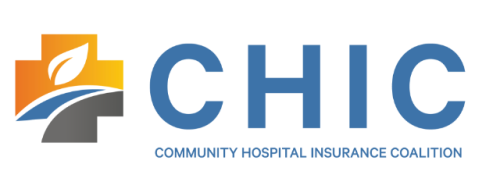Webinar Series: Compliance Updates
IRS Adjusts 2018 HSA Contribution Limit – Again
ICYMI: IRS Allows Small Business Tax Credit for Non-Marketplace Plans
IRS Updates Employer Guide for 2018 Tax Changes to Fringe Benefits
Did You Miss the April 2 ACA Reporting Deadline? Here’s What’s Next.
Did You Know? Reference-Based Pricing
Webinar Series: Compliance Updates

HealthSure invites you to participate in the TASC Webinar Series May – June 2018. Attendees belonging to SHRM and HRCI are eligible for CE Credits by attending eligible webinars.
Click here to view the schedule then click the link next to the date/time of the webinars that best suit your schedule and register. (All times are CDT.)
IRS Adjusts 2018 HSA Contribution Limit – Again
by Marathas Barrow Weatherhead Lent LLP, a national law firm with recognized experts on the Affordable Care Act.

The IRS has announced it is modifying the annual limitation on deductions for contributions to a health savings account (“HSA”) allowed for taxpayers with family coverage under a high deductible health plan (“HDHP”) for the 2018 calendar year. Under Rev. Proc. 2018-27, taxpayers will be allowed to treat $6,900 as the annual limitation, rather than the $6,850 limitation announced in Rev. Proc. 2018-18 earlier this year.
The HSA contribution limit for individuals with family HDHP plan coverage was originally issued as $6,900 last May in Rev. Proc. 2017-37. Earlier this year, the IRS announced a $50 reduction in the maximum deductible amount from $6,900 to $6,850 due to changes made by the Tax Cuts and Jobs Act.
Due to widespread complaints and comments from individual taxpayers, employers and other major stakeholders, the IRS has decided it is in the best interest of “sound and efficient” tax administration to allow individuals to treat the originally released $6,900 as the 2018 family limit. The IRS acknowledged that many individuals had already made the maximum HSA contribution for 2018 before the deduction limitation was lowered and many other individuals had made annual salary reduction elections for HSA contributions through employers’ cafeteria plans based on the higher limit. Additionally, the costs of modifying various systems to reflect the reduced maximum would be significantly greater than any tax benefit associated with an unreduced HSA contribution.
| Revised 2018 HDHP and HSA Limits | Single / Family |
| Annual HSA Contribution Limit | $3,450 / $6,900 |
| Minimum Annual HDHP Deductible | $1,350 / $2,700 |
| Maximum Out-of-Pocket for HDHP | $6,650 / $13,300 |
Rev. Proc. 2018-27 provides guidance for those taxpayers who already took a distribution in 2018 from their HSA based on the reduced maximum limit of $6,850. Anyone who receives a distribution from an HSA in excess of the $6,850 limit may treat that distribution as the result of a “mistake of fact due to reasonable cause.” The portion of a distribution (including earnings) that an individual repays to the HSA by April 15, 2019, will not be included in the individual’s gross income or be subject to the 20% additional tax for non-medical distributions. The repayment will not be subject to the 6% excise tax on excess contributions either. Mistaken distributions that are repaid to an HSA are not required to be reported on Form 1099-SA or Form 8889 and are not required to be reported as additional HSA contributions.
Alternatively, if an individual decides not to repay such a distribution it will not have to be included in gross income or subject to the additional 20% tax as long as the distribution is received by the individual’s 2018 tax return filing due date. This tax treatment, however, does not apply to contributions from an HSA that are attributable to employer contributions if the employer does not include any portion of the contributions in the employee’s wages because the employer treats $6,900 as the annual contribution limit. In that scenario, the distribution would be included in the individual’s gross income and subject to the 20% additional tax unless it was used to pay for qualified medical expenses. In other words, if the employee withdraws the $50 and does not return it to the HSA, it’s not includible in income or subject to the 20% additional tax unless the $50 is reported as an employer contribution on the employee’s W-2 (in box 12, code W), in which case it would be includible in income and subject to the 20% additional tax.
Employers who previously informed employees that the limit was lowered should consider informing them now about the new limit and repayment option.
ICYMI: IRS Allows Small Business Tax Credit for Non-Marketplace Plans
by NAHU
Last Friday, the IRS released Notice 2018-17 that permits small employers to claim the small business tax credit (SBTC) for non-marketplace coverage if there are no options available on the small business health options (SHOP) marketplace. The notice applies for 2017 and beyond and states that the employer’s plan must meet the requirements for the tax credit in place prior to 2014. The National Association of Health Underwriters (NAHU) supports efforts at the regulatory and legislative level to expand the availability of the SBTC to provide small employers meaningful access to affordable coverage for their employees.
The SBTC was included as part of the ACA to encourage small employers to provide health insurance to their employees, as roughly half of small employers offer health benefits to their workers. Unfortunately, many employers have been unable to claim the credit due to the current eligibility limitations. Currently, credits are available to eligible small employers of up to 25 full-time equivalent employees (FTEs) that pay an average annual wage of less than $50,000. Full credits are available to eligible small employers of up to 10 FTEs with an average annual wage of $25,000 or less.
As a result of these limited qualification parameters, many employers who wanted to be able to access the SBTC simply don’t qualify, which has resulted in fewer employers claiming the credit than had been expected. Initial projections showed that as many as 4 million small employers would claim the credit through 2019, claiming $40 billion worth of credits; however, there has been less than $1 billion actually claimed. Most small employers who didn’t claim the credit said it was because the wage eligibility standards were too stringent, while others cited the overly complicated process for calculating the credit, which discouraged many from even applying.
NAHU has advocated for legislation that would expand the SBTC to more small employers to help them claim the credit and offer their employees coverage. The Senate legislation, S. 1254, introduced by Senator Debbie Stabenow (D-MI) would provide a 50% credit for all businesses with 50 or fewer employees, with a phase-out starting at $50,000 in average wages. The bill would further strike the two-year limit for the tax credit, allowing employers to claim the credit on an annual basis. The House bill, H.R. 432, was introduced by Representative Suzan DelBene (D-WA) and would only increase the length that employers could claim the credit from two to three years, instead of in perpetuity. Her bill would also increase the threshold for eligible individuals from 10 to 20, and raise the size of businesses eligible from 25 to 50.
While the IRS regulation issued last week does not address the limited eligibility concerns that are addressed in the legislation, it does help to expand eligibility of the credit by allowing those already eligible to find additional plan offerings to purchase than those traditionally available under the credit. NAHU applauds efforts to provide some relief to employers seeking to provide coverage to their employees and encourages Congress to advance legislation to further expand eligibility of the credit.
IRS Updates Employer Guide for 2018 Tax Changes to Fringe Benefits

The IRS recently released the 2018 version of Publication 15-B—Employer’s Tax Guide to Fringe Benefits, which contains information for employers on the tax treatment of fringe benefits. The 2018 version is significant because it incorporates the changes made by the new tax law—the Tax Cuts and Jobs Act—to the following fringe benefits:
- Qualified transportation plans
- Moving expense reimbursements
- Employer-provided meals
- Employee achievement awards
Employers that offer fringe benefits should review the 2018 version of Publication 15-B and work with their tax advisors to implement the tax changes.
Did You Miss the April 2 ACA Reporting Deadline? Here’s What’s Next.

The Affordable Care Act (ACA) created reporting requirements under Internal Revenue Code Sections 6055 and 6056 that require certain employers to provide information to the IRS about the health plan coverage they offer (or do not offer) to their employees.
The annual deadline for the 2017 calendar year was Feb. 28, 2018, or April 2, 2018 (March 31, 2018, being a Saturday), if filed electronically. Missing this deadline can result in severe penalties of $260 per return with a maximum penalty of $3,218,500 per organization. Moreover, if the IRS determines that an organization intentionally failed to file their reports, the penalty amount will be $530 per return without limitations.
What to do if You Missed the Deadline
If you missed the filing deadline, it’s important to remember that filing late is better than not filing at all. It can also result in a reduced penalty amount.
If an organization files within 30 days of the due date, the IRS will reduce the penalty for late filings from $260 to $50. Filing after 30 days past the due date but before Aug. 1 will result in a penalty of $100 per return with a maximum of $1,609,500.
For More Information
To learn more about ACA reporting requirements, or what else you can do if you missed the deadline, please contact us today.
A Virginia court is considering a lawsuit involving reference-based pricing (RBP) and balance billing. The case, Glenn Dennis v. Memorial Hospital of Martinsville & Henry County, appears to be the first balance billing case to go to trial and could determine how courts decide these disputes in the future.
RBP is a self-funded cost containment strategy where employers set a pricing cap on the maximum amount that the plan will for certain medical services that have wide cost variations, such as knee and hip replacement surgery. Managing cost savings are beneficial to the overall cost of the plan but the difference between the allowed amount and the billed charges is subject to balance billing. Not all hospitals write-off the difference, so education is important to ensure employees understand the steps to take if they encounter balance billing. In the case at hand, the hospital is being sued for balance billing. HealthSure is monitoring this case and will keep you informed on the outcome.



